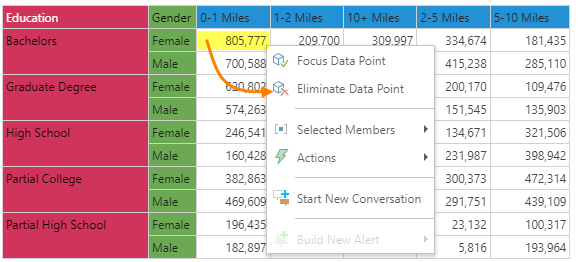Member and Data Point Selection allow users to easily and intuitively select elements and data points for analysis directly from visualizations - in effect allowing the user to 'zoom' in on relevant data for analysis and offering users a powerful and fluid way to perform contextual ad-hoc analysis. Interactive Element (member) and Data Point selection capabilities extend the capabilities of the more comprehensive element selection capabilities in element trees and / or the Elimination Wizard.
There are two variations in the functionality depending on how the it is triggered and the target item(s):
- Member (Element) Selection: This capability involves selecting (or eliminating) one or more hierarchy elements using the "Focus" and "Eliminate" menu options. This capability is a shortcut for the capabilities found in element trees. It can also optionally be implemented through the Elimination Wizard - which keeps track of any actions performed through the context menu.
- Data Point Selection: This capability involves selecting (or eliminating) one ore more data points from a query using the "Focus Data Point" and "Eliminate Data Point" menu options. Intrinsically, a data point is a COMBINATION of elements - and it can only be implemented through the context menu functions (described in this topic) or via the Eliminations Wizard. This type of capability cannot be done through the element trees.
The commentary in the Elimination wizard expands on these concepts further. The techniques for making simple selections and multi-selections on visuals is described below, and covered in-depth here.
Using Selections
Member Selection: Focus and Eliminate
Interactively selecting members or elements, is a fast, direct and effective technique to focus the report on the key elements driving results. Likewise, eliminating members is a fast and effective technique for removing specific 'noise' from the analysis.
To eliminate members, simply right click on the member (in this case we right-clicked on 'Female'), choose Member Selection and then choose to 'Focus' on it or 'Eliminate' it.
If the axis that contains the member has two or more hierarchies (like in this example is contains Education and Gender), then the Eliminate option will include a fly-out where you can choose to eliminate just females (the default) or the combination of bachelors and females. As mentioned, you could focus and eliminate the 'Female' element from the element trees, but the ability to eliminate the combination of 'bachelors and females' can only be done through the context menu or the Elimination Wizard.
See below for guidance on how to focus or eliminate multiple members.

This functionality can operate off chart axes like the columns and rows of a grid as well as off the legends attached to any visualization. For a legend, right click on the element label, select Member Selection and then click Eliminate or Focus.

Focus and Descendants
If you are using a multi-level OLAP or 'Regular' hierarchy, the Member Selection menu offers the ability to focus on the current element item and show all its descendant child elements in a single click using the 'Focus and Descendants' function.
- Click here for more details on this specific feature.
Note: You CAN use member focus or eliminations with Totals.
Focus and Eliminate Data Point
Like member only selections, interactively selecting cells or data points is a fast, direct and effective technique to focus the report on the key values driving results. Likewise, eliminating data points is a fast and effective technique for removing specific 'noise' from the analysis. As mentioned, data point focus and eliminate is only available via the context menu or Eliminations Wizard.
To eliminate data points, simply right click on the cells or data points (in this case we right-clicked on 'Bachelor, Female, 0-1 Miles'), and then choose to 'Focus Data Point' or 'Eliminate Data Point'.

In this case, we chose to eliminate the data point - and you can see the item has been removed from the query.

Note: You CANNOT currently use data point eliminations together with Totals.
As mentioned, the ability to focus or eliminate a combination of items (a 'data point') can only be done through the context menu or the Elimination Wizard. See below for guidance on how to focus or eliminate multiple data points.
Multiple Selections
Member and Data Point actions are typically done by eliminating more than one item for a given report or visualization. As such, the ability to then perform these actions across multiple selected items at a time becomes very important. Pyramid offers two techniques for making multiple selections depending on the visualization and the features visible for the given visualization:
- Multiple clicks using the CTRL key and left mouse button - useful for picking non-contiguous selections
- The Lasso tool for picking a contiguous set of items
Both techniques simply select the items. Once selected, the user can right-click and choose the relevant operation to perform - specifically focus or eliminate.
This functionality is explained in more detail here.